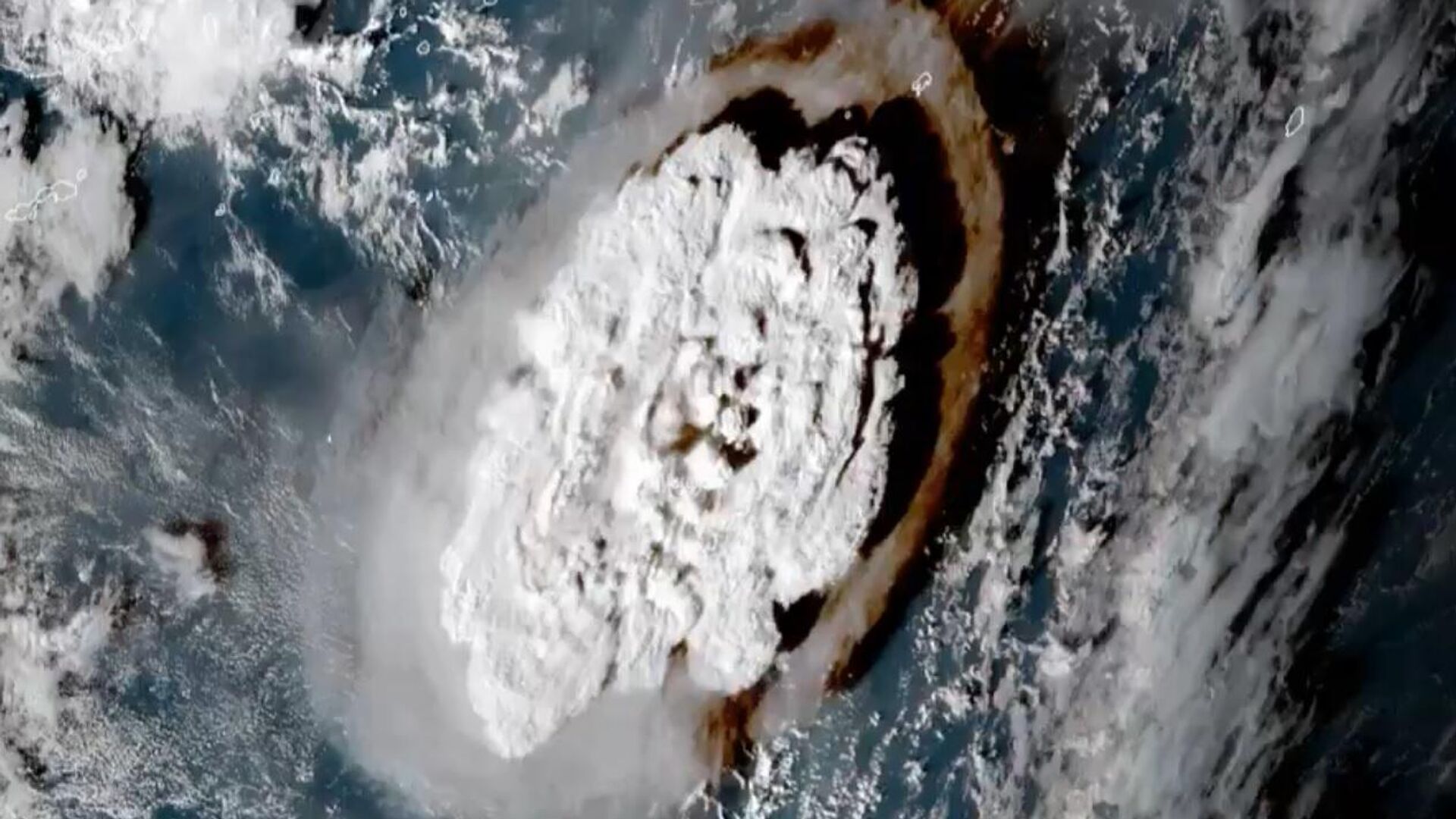https://sputnikglobe.com/20220803/tonga-volcano-spewed-58000-olympic-pools-worth-of-water-into-space-damaging-ozone-layer-1098079918.html
Tonga Volcano Spewed 58,000 Olympic Pools-Worth of Water Into Space, Damaging Ozone Layer
Tonga Volcano Spewed 58,000 Olympic Pools-Worth of Water Into Space, Damaging Ozone Layer
Sputnik International
The January 15 Hunga Tonga-Hunga Ha'apai eruption occurred below the Pacific seabed near Tonga, triggering a tsunami wave across the region. Satellite images... 03.08.2022, Sputnik International
2022-08-03T15:58+0000
2022-08-03T15:58+0000
2022-11-03T19:33+0000
tonga
south pacific
pacific ocean
atmosphere
stratosphere
ozone layer
climate change
volcano
nasa
researchers
https://cdn1.img.sputnikglobe.com/img/07e6/01/0f/1092277001_0:49:1265:761_1920x0_80_0_0_d7a56fa8fb40bebb7882071a7290fece.jpg
The mighty Hunga Tonga-Hunga Ha'apai eruption last January blew out a record amount of water, worsening the ozone layer’s depletion, NASA scientists Luis Millan and his team have concluded.According to their study examining the water content blasted from the underwater eruption, the January 15 explosion sent around 146 teragrams (equal to 146 trillion grams) of water vapor into Earth's stratosphere – enough to fill more than 58,000 Olympic-size swimming pools.The extra water vapor caused by the underwater eruption could trigger "certain chemical reactions," resulting in a temporary worsening depletion of the ozone layer, the space agency said in a release."We've never seen anything like it," Millan, an atmospheric scientist at NASA's Jet Propulsion Laboratory in Southern California, said.Unlike other massive volcanic eruptions like Krakatoa and Mount Pinatubo, which cooled Earth's surface by ejecting gases, dust, and ash, the Tonga eruption "could influence surface temperatures."Scientists observed that the Tonga volcano didn't inject large amounts of aerosols into Earth's atmosphere, and the amount of vapor that will remain in the stratosphere could absorb heat, which may lead to an increase in surface temperature.Millan and his team used the data captured by the Microwave Limb Sounder (MLS) instrument of NASA's Aura satellite to analyze the impact of the sheer amount of water vapor injected into the stratosphere.Scientists believe that the depth of the volcano's caldera, which was 150 meters below the ocean surface, brought massive power to spew water in huge amounts. A caldera is a basin-shaped depression usually formed after magma erupts or drains from a shallow chamber beneath the volcano.
tonga
south pacific
pacific ocean
earth
Sputnik International
feedback@sputniknews.com
+74956456601
MIA „Rossiya Segodnya“
2022
Rishikesh Kumar
https://cdn1.img.sputnikglobe.com/img/07e4/08/04/1080055820_0:0:388:389_100x100_80_0_0_40018ee210946d65d49ffba4f4c008e1.jpg
Rishikesh Kumar
https://cdn1.img.sputnikglobe.com/img/07e4/08/04/1080055820_0:0:388:389_100x100_80_0_0_40018ee210946d65d49ffba4f4c008e1.jpg
News
en_EN
Sputnik International
feedback@sputniknews.com
+74956456601
MIA „Rossiya Segodnya“
Sputnik International
feedback@sputniknews.com
+74956456601
MIA „Rossiya Segodnya“
Rishikesh Kumar
https://cdn1.img.sputnikglobe.com/img/07e4/08/04/1080055820_0:0:388:389_100x100_80_0_0_40018ee210946d65d49ffba4f4c008e1.jpg
tonga, south pacific, pacific ocean, atmosphere, stratosphere, ozone layer, climate change, volcano, nasa, researchers, geologist, sputnik, earth
tonga, south pacific, pacific ocean, atmosphere, stratosphere, ozone layer, climate change, volcano, nasa, researchers, geologist, sputnik, earth
Tonga Volcano Spewed 58,000 Olympic Pools-Worth of Water Into Space, Damaging Ozone Layer
15:58 GMT 03.08.2022 (Updated: 19:33 GMT 03.11.2022) The January 15 Hunga Tonga-Hunga Ha'apai eruption occurred below the Pacific seabed near Tonga, triggering a tsunami wave across the region. Satellite images captured the giant volcanic ash rising in the air, with scientists finding that it reached the stratosphere.
The mighty Hunga Tonga-Hunga Ha'apai eruption last January blew out a record amount of water, worsening the ozone layer’s depletion, NASA scientists Luis Millan and his team have concluded.
According to their study examining the water content blasted from the underwater eruption, the January 15 explosion sent around 146 teragrams (equal to 146 trillion grams) of water vapor into Earth's stratosphere – enough to fill more than 58,000 Olympic-size swimming pools.
The amount is equivalent to 10% of the water already present in the atmospheric layer, which sits 12 to 53 kilometers above the Earth's surface, the study published in the Geophysical Research Letters estimated.
The extra water vapor caused by the
underwater eruption could trigger "certain chemical reactions," resulting in a temporary worsening depletion of the ozone layer, the space agency said in a release.
"We've never seen anything like it," Millan, an atmospheric scientist at NASA's Jet Propulsion Laboratory in Southern California, said.
Unlike other massive volcanic eruptions like Krakatoa and Mount Pinatubo, which cooled Earth's surface by ejecting gases, dust, and ash, the Tonga eruption "could influence surface temperatures."
Scientists observed that the
Tonga volcano didn't inject large amounts of aerosols into Earth's atmosphere, and the amount of vapor that will remain in the stratosphere could absorb heat, which may lead to an increase in surface temperature.
However, the increase in surface temperature would not be "enough to noticeably exacerbate climate change effects."
Millan and his team used the data captured by the Microwave Limb Sounder (MLS) instrument of NASA's Aura satellite to analyze the impact of the sheer amount of water vapor injected into the stratosphere.
Scientists believe that the depth of the volcano's caldera, which was 150 meters below the ocean surface, brought massive power to spew water in huge amounts. A caldera is a basin-shaped depression usually formed after magma erupts or drains from a shallow chamber beneath the volcano.


